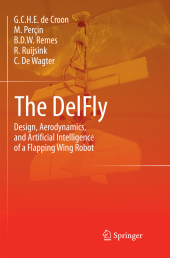 Neuerscheinungen 2019Stand: 2020-02-01 |
Schnellsuche
ISBN/Stichwort/Autor
|
Herderstraße 10
10625 Berlin
Tel.: 030 315 714 16
Fax 030 315 714 14
info@buchspektrum.de |

G.C.H.E. de Croon, M. Per‡in, B. D. W. Remes
(Beteiligte)
The DelFly
Design, Aerodynamics, and Artificial Intelligence of a Flapping Wing Robot
Softcover reprint of the original 1st ed. 2016. 2019. xiv, 218 S. 113 SW-Abb., 11 Farbabb., 150 Farbtab
Verlag/Jahr: SPRINGER NETHERLANDS; SPRINGER 2019
ISBN: 9402414053 (9402414053)
Neue ISBN: 978-9402414059 (9789402414059)
Preis und Lieferzeit: Bitte klicken
This book introduces the topics most relevant to autonomously flying flapping wing robots: flapping-wing design, aerodynamics, and artificial intelligence. Readers can explore these topics in the context of the "Delfly", a flapping wing robot designed at Delft University in The Netherlands.
How are tiny fruit flies able to lift their weight, avoid obstacles and predators, and find food or shelter? The first step in emulating this is the creation of a micro flapping wing robot that flies by itself. The challenges are considerable: the design and aerodynamics of flapping wings are still active areas of scientific research, whilst artificial intelligence is subject to extreme limitations deriving from the few sensors and minimal processing onboard.
This book conveys the essential insights that lie behind success such as the DelFly Micro and the DelFly Explorer. The DelFly Micro, with its 3.07 grams and 10 cm wing span, is still the smallest flapping wing MAV in the world carrying a camera, whilst the DelFly Explorer is the world´s first flapping wing MAV that is able to fly completely autonomously in unknown environments. The DelFly project started in 2005 and ever since has served as inspiration, not only to many scientific flapping wing studies, but also the design of flapping wing toys.
The combination of introductions to relevant fields, practical insights and scientific experiments from the DelFly project make this book a must-read for all flapping wing enthusiasts, be they students, researchers, or engineers.
1 Introduction
Part I Design and Materials
2 Introduction to FlappingWing Design
3 Mechanical design and materials
4 Electronics
Part II Aerodynamics
5 Introduction to fixed and flapping wing aerodynamics
6 Research on the DelFly aerodynamics
Part III Autonomous Flight
7 Introduction to autonomous flight
8 Monocular obstacle detection
9 Optical flow based turning logic
10 Autonomous flight with onboard stereo vision
Part IV Conclusions
11 Conclusions and future research
A DelFly Versions
Glossary
Index
Guido de Croon: Received his M.Sc. and Ph.D. in the field of Artificial Intelligence (AI) at Maastricht University, the Netherlands. His research interest lies with computationally efficient algorithms for robot autonomy, with a particular focus on computer vision. Since 2008 he has worked on algorithms for achieving autonomous flight with small and light-weight flying robots, such as the DelFly. In 2011-2012, he was a research fellow in the Advanced Concepts Team of the European Space Agency, where he studied topics such as biologically inspired algorithms for extraterrestrial landing scenarios and where he introduced "Astro Drone", the first scientific crowd sourcing experiment gathering robotic data. Currently, he is assistant-professor at the Micro Air Vehicle lab (MAV-lab) of Delft University of Technology.
Mustafa Per‡in: Obtained his B.Sc. degree in Aeronautical Engineering from Istanbul Technical University in 2007, ranking first among the graduating class of 2007 in the university. In 2009, he received his M.Sc. degree in Aeronautical- Astronautical Engineering from Istanbul Technical University with the thesis titled "Flow around a plunging airfoil in a uniform flow". Subsequently, he obtained a research master at the von Karman Institute for Fluid Dynamics in 2010. He started his Ph.D. research in the Aerospace Engineering Faculty of Delft University of Technology in 2011. He received his Ph.D. degree with the thesis titled "Aerodynamic mechanisms of flapping flight" in September 2015. His research interests are flapping and fixed wing aerodynamics, and experimental fluid mechanics (non-intrusive flow measurement techniques).


